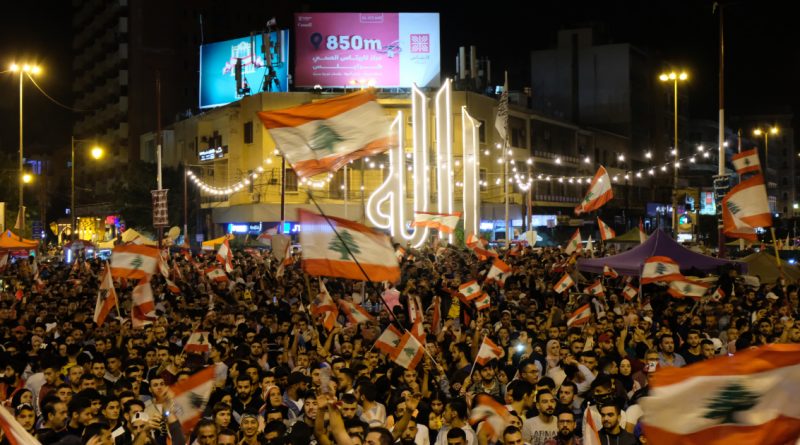Lebanon’s year of fire | Middle East News
Beirut, Lebanon – From his home nestled in the lush mountains above Beirut, Salim Abou Moujahed watched flames eat up foliage on an opposing hillside.
The 32-year-old had been intrigued by fire since his childhood days spent outdoors in the rugged wilderness of Aley. Tonight, however, the fire was infernal, quick-moving, unpredictable. Soon enough, bone-dry shrubbery a few dozen metres from where he sat began to crackle.
He quickly got up and rushed towards the blaze, armed with basic fire-fighting equipment on hand in his village, Btater.
Once Abou Moujahed was there, the scale of the fire became clear. He sent four frantic voice messages to friends on a local WhatsApp group.
“Whoever has a cistern come now!”
“The neighborhood is on fire!”
It was October 14, 2019, and Aley, just like the neighbouring Chouf mountains and much of Lebanon, was engulfed in what would become the country’s worst wildfires in decades.
Across the mountains that rise steeply out of the Mediterranean, hundreds fled their homes under a night sky that burned an atomic orange. Embers carried by powerful dry winds sprouted fires across vast distances. Flame fronts tens of metres high thundered over hills and leaped across valleys.
“The scenes here bring tears to my eyes,” a news reporter cried, as red-hot coals whizzed through the air around her.
“I really can’t control myself, people are screaming from their homes … There is no one to help them.”
Those on Abou Moujahed’s WhatsApp group were busy responding to fires of their own. They knew no one else would: the Lebanese state had in the past shown it had neither the strategy nor the equipment to help them.
Salim, 32, was left on his own.
He returned home later that night covered in soot and visibly exhausted. Then, the father of two collapsed. His family rushed him to a hospital.
Just before 2am, he was pronounced dead of a heart attack, apparently caused by overexertion and smoke inhalation.
“Regrettably, this state doesn’t have the capacity to help us, it only has the capacity to steal and plunder and take from us,” said Salim’s brother, Wissam.
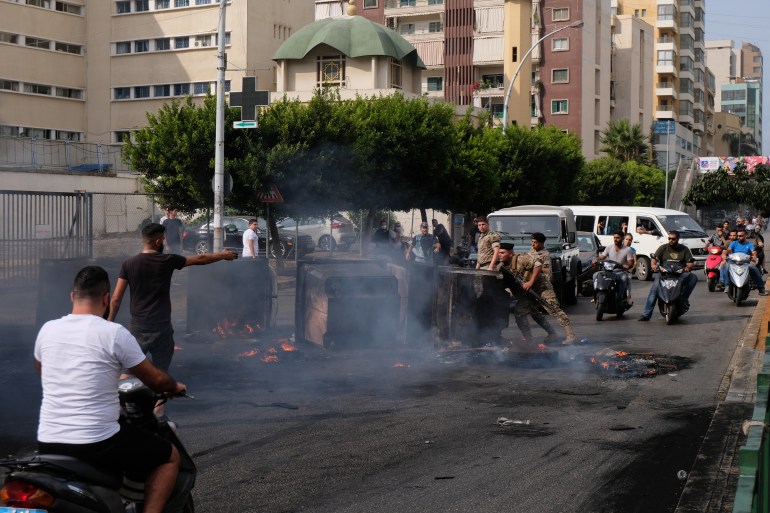 Soldiers attempt to clear a road during nationwide protests in Lebanon [Timour Azhari/Al Jazeera]
Soldiers attempt to clear a road during nationwide protests in Lebanon [Timour Azhari/Al Jazeera]Lebanon’s rickety state, hollowed out by sectarian politicians who never relinquished the militia mindset that first brought them to power during a 15-year civil war, had once again failed the people.
Three fire-fighting helicopters donated to the state had been left to fall into disrepair by successive governments that failed to fund maintenance.
The fires were left to gobble up green plains and mountains, the pride of Lebanon immortalised in the country’s national anthem as “the birthplace of men”.
Officials could offer little more than the promise of an investigation into the helicopter matter, ordered by President Michel Aoun.
Then, they pleaded for help from the international community – the habit of a group of men whose grip on power has been sustained by decades of foreign intervention.
People were left to fend for themselves. They banded together as the world burned around them, organising temporary shelter, food, water and medication for those affected by the fires.
When a government minister came to visit the biggest volunteer centre in Chouf, he was unceremoniously kicked out.
“He came to a place where we were working to do what his state had failed to do, so we let him know he’s not welcome,” said Nada Nassif, a 32-year-old Chouf resident who helped organise the distribution of aid at the centre. “We were furious.”
The fires in three days scorched more than what usually perishes in an entire year in Lebanon. A molten mix of anger and grief swept across the country.
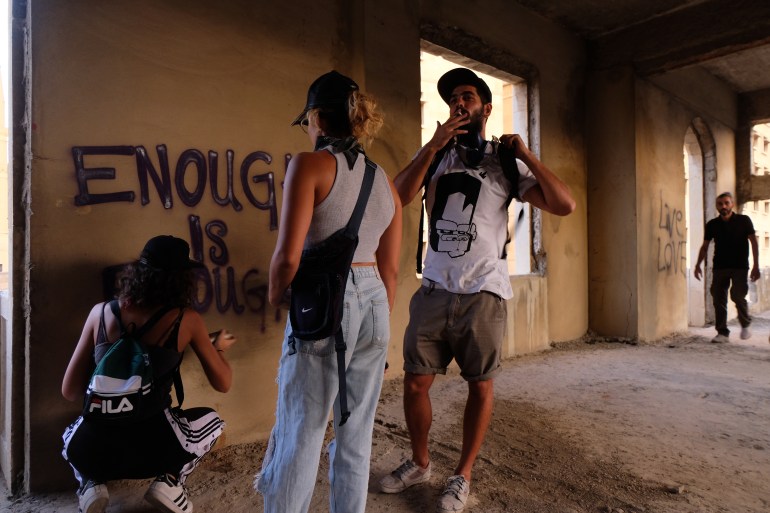
The currency imploded. Beirut’s port erupted like a dormant volcano. Whole city blocks were cracked open and regularly burst into flames as gas canisters exploded along with diesel storage tanks and electricity generators.
Lives were cut short and others were forever disfigured; friends were lost to death or departure and every day a novel trauma inflamed wounds that had just been sustained, never giving them time to heal.
But first – there was hope.
Barrier of fear is torn down
The country was still smouldering when the cabinet met the morning of October 16 to endorse a set of budget cuts and taxes, part of what Prime Minister Saad Hariri described as “unprecedented” austerity that his coalition government was imposing to prevent total collapse.
The next day, it surfaced that the cabinet endorsed a tax of up to $6 per month on WhatsApp, widely used as an alternative to Lebanon’s state-run mobile duopoly that has fees that run among the highest in the world.
It was an insult to people who had just seen their country burn. “I mean, how shameless can you be?” Nassif said.
In response to the fires, Li Haqqi (For My Rights), an independent political group that Nassif volunteers with, had planned a protest the coming Monday. But news of the taxes drove them to call it immediately, at 6pm on the 17th.
Three days volunteering in the Chouf left Nassif tired. The fatigue of five years of activism, since 2015 demonstrations sparked by a waste management crisis, left her weary of protest.
“We would pretty much just go to the streets to see friends, and then go back home,” she said. But she decided to head down anyway.
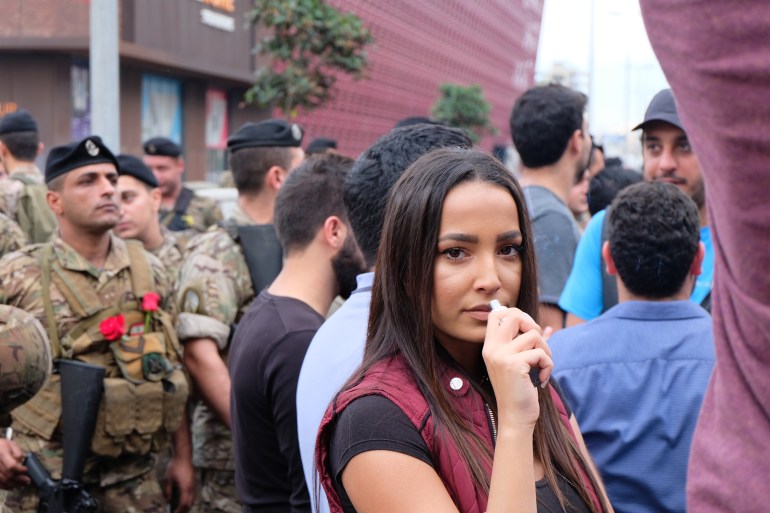 A woman joins protesters in occupying a highway north of Beirut [Timour Azhari/Al Jazeera]
A woman joins protesters in occupying a highway north of Beirut [Timour Azhari/Al Jazeera]As the sun set, a few dozen people gathered in Beirut’s central Riad al-Solh Square, near parliament and the Grand Serail, the seat of government.
They marched in a loop to the Ring Bridge, a flyover that connects eastern and western Beirut, and on to Hamra Street, a formerly bustling commercial district.
The numbers slowly grew. They passed through the glitzy downtown Beirut district and spotted a convoy of cars with tinted windows: the unmistakable sign of an official (Education Minister Akram Chehayeb).
Dozens prevented the car from moving. Suddenly, the front door burst open and shots rang out. A squat man with an assault rifle fired into the air and pushed protesters aside, ordering them to make way.
An incredulous shout: “What are you shooting at?”
A protester beat his chest and screamed. “Shoot! Shoot! Shoot!”
Chehayeb exited the car and pushed the bodyguard back. Another climbed onto its roof and brandished his weapon.
More joined in: “Shoot! Shoot! Shoot!”
Shots rang out.
A protester climbed onto the car and tore off his shirt, daring the armed man in front of him: “Shoot! Shoot! Shoot!
In the background, an armed bodyguard stumbled between protesters, then was kicked squarely in the groin by a woman, Malak Alawiye. The image instantly became a symbol of defiance – of a barrier of fear torn down.
The earth quaked. Reality jumped tracks. People stormed into the streets. From Tripoli in the north to Tyre in the south, Baalbeck in the east and all across the Bekaa and Beirut and its suburbs: “The people demand the downfall of the regime!”
It was the greatest show of unity Lebanon had ever seen. “Everything is ours,” read graffiti spray-painted onto a wall in Beirut.
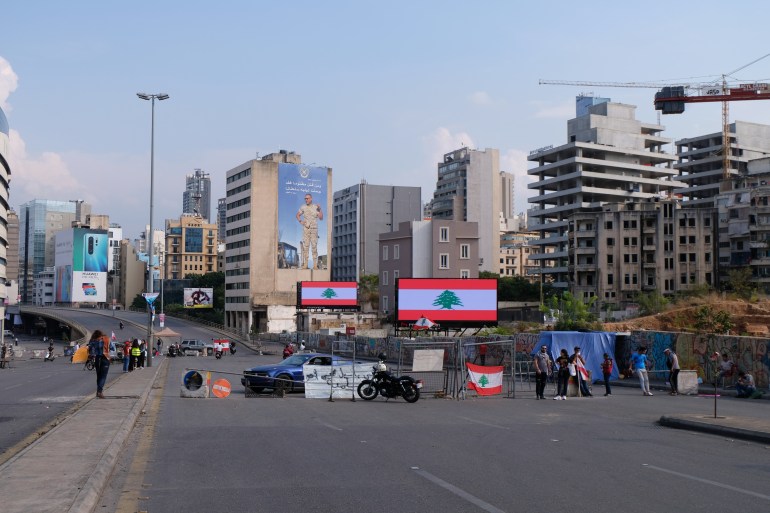 A roadblock by protesters in downtown Beirut [Timour Azhari/Al Jazeera]
A roadblock by protesters in downtown Beirut [Timour Azhari/Al Jazeera]At Martyrs’ Square, a towering bonfire roared at a main intersection in front of the iconic blue Mohammad al-Amin Mosque and St George Maronite Christian cathedral, in an angry rebuke of the picture-perfect image of coexistence that the country’s sectarian leaders proclaimed themselves the keepers of.
The air filled with profanity-laced slogans that tore apart the gilded images of politicians accustomed to royal treatment.
Protesters rose up in peripheral areas regularly described as “strongholds” of sectarian parties; they smashed the offices of Hezbollah MPs in southern Nabatieh, and attacked the homes of politicians belonging to major parties in Tripoli.
“Look at how the country has spit you out, there is no place for you anymore,” Lebanese rapper El Rass said to politicians in his song Shouf or “Look.”
“My people have destroyed their idols, now nothing is impossible.”
An ‘open-mic revolution’
Around 11pm, Telecommunications Minister Mohammad Choucair announced he would cancel the WhatsApp tax.
A reporter asked a young protester what he thought.
“F*** him.”
“Why?” the reporter asked.
“Because he f***** us over,” the man spat.
“Is this the kind of language that you think will get your message across?” she asked.
“I’m not trying to send him a message – F*** his sister.”
In a brazen manner, protesters took over the soundscape. One chant – which rhymes “Helo Ho” and a crude reference to the foreign minister’s mother’s genitals – was everywhere by the second night, sung by thousands in Beirut.
It spread across the country like wildfire. People went to bed hearing it in their heads. Memes featured it, T-shirts were imprinted with it, no TV interview on the street could take place without it being heard in the background.
It was, as Lebanese investigative journalist Habib Battah put it, an “open-mic revolution” where all officials were wiped off the screens and replaced by the round-the-clock live feed of people speaking from the streets – angry, fed up, cursing.
They voiced grievances about perennial power cuts and poverty, about corruption and being forced to emigrate and the sectarian political system that enabled all of the dysfunction.
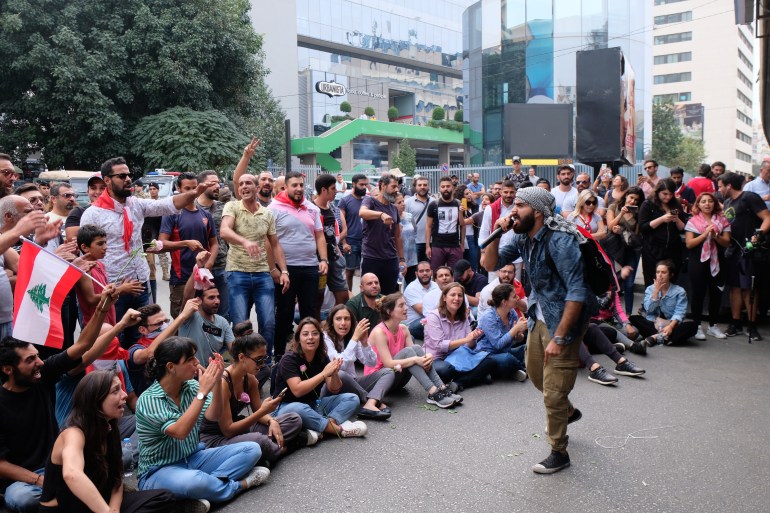 A man leads a chant under Beirut’s Ring Bridge [Timour Azhari/Al Jazeera]
A man leads a chant under Beirut’s Ring Bridge [Timour Azhari/Al Jazeera]Over the next few days, well over one million Lebanese – some 20 percent of the population – filled the streets.
So did thousands in the diaspora from Los Angeles to Sydney, London to Madrid, Mexico City and Paris, suddenly drawn back towards a country that had pushed them away.
Protest encampments sprung up. Everything was cared for by an army of volunteers and piles of incoming donations, from food and water to shelter and speakers.
Kitchens were set up, as were medical tents and play areas for children.
Groups of musicians and actors toured streets putting on shows – “We want to dance, we want to sing, we want to bring down the regime,” they chanted. Football and frisbee were played in Riad al-Solh and on the Ring Road; debates and discussions reverberated through reclaimed buildings along with lectures and movie screenings, group therapy sessions, performances and several raves.
Far from just demanding a country that closer fit their aspirations, protesters were creating it on the ground, and soon began to build alternative institutions, such as independent unions.
Tarek Chehab, the 34-year-old owner of a 3D decorations company, decided he too had to contribute.
“‘I said, ‘let’s do something big.’ It was as spontaneous as that,” he says.
At his factory, he asked an employee to look for revolutionary images, and picked a raised, clenched fist: a universal symbol of defiance and solidarity.
The nine-metre icon was cut out, imprinted with the word “Revolution” and raised in Martyrs’ Square. Many other areas then followed suit.
As the protests grew, attacks began – verbal at first – by establishment parties who accused them of being funded by foreign embassies.
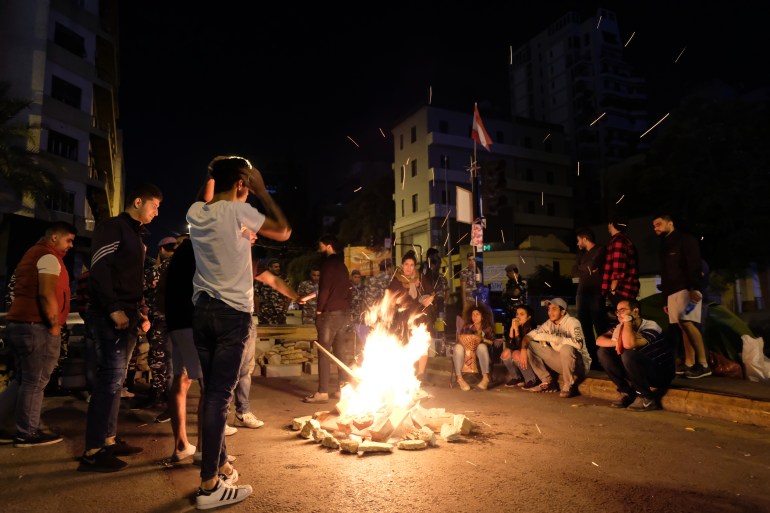 Protesters warm themselves by a fire on the main Beirut Ring Bridge [Timour Azhari/Al Jazeera]
Protesters warm themselves by a fire on the main Beirut Ring Bridge [Timour Azhari/Al Jazeera]People took it in stride, were brilliant in their rebuttals: “Who is funding the revolution?” someone would shout out. “Me!” everyone replied gleefully.
Waving a small bottle of tequila at a protest encampment on the Ring Bridge, one man teased: “Look what the Mexican embassy got for me.”
Protesting became second nature. People fell in love with the simple power of the streets, and many who passed through that time talk of an unspeakable attraction to those around them as social bounds let loose.
Born into a country of pockmarked buildings, members of a generation finally got to know each other without the weight of history on their shoulders.
“Don’t you dare try to convince us that you are protecting our religions,” a young female student who skipped school to protest said, in a widely shared TV clip.
“You could convince our grandparents of that, you could use that to convince our parents, but us? No. I don’t want Christian rights, nor Muslim rights, as long as I don’t have the right to food and water and electricity,” she said, her voice hoarse from chanting.
So momentous was the occasion that many felt the gains made could not be lost.
From Shouf, the song by El Rass: “Look how far we’ve come, Look how far we’ve come, look at what we built and look at what we’ve destroyed. They united us in our suffering, so we became a people and won.”
Weakest link breaks
Those first days and weeks existed in a space seemingly outside of time – as if the country had ground to a halt.
“Road closed for maintenance of the nation,” one sign on a Beirut thoroughfare read.
But in the space of a few days, reality came crashing back in.
It began with October 29: a day of two pivotal events. Around noon, hundreds of supporters of Hezbollah – an armed militia and leading political force – and its main ally Amal amassed on the Ring Bridge.
They had come to open the road. The men charged peaceful protesters, sparing no one in a rampage that swept first across the bridge, and then into the protest encampment nestled in Martyrs’ Square.
Some moved as if in formation, shouting slogans that praised their leaders, along with the sectarian chant, “Shia, Shia Shia.”
The words poisoned the soundscape of the reclaimed downtown area; a vulgar expression of primitive identity that protesters believed they had rendered irrelevant.
The men shredded tents, smashed large pots and pans and cracked open Tupperware containers filled with food – multicolored pasta salad. They emptied water bottles and bashed speakers and stage equipment.
Then, they set fire to what remained.
“This is the real revolution,” said one of the men to another as they stood on the sidelines, smirking.
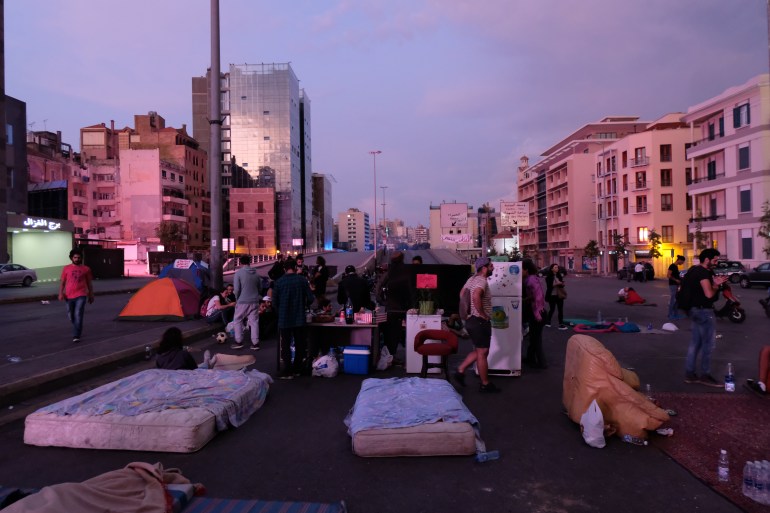 The sun rises on the protest camp [Timour Azhari/Al Jazeera]
The sun rises on the protest camp [Timour Azhari/Al Jazeera]As the world spun around him, one member of the riot police splashed the contents of a mostly empty bottle of water onto a flaming tent, in a futile attempt to put it out.
Security forces on site, initially outnumbered, pushed the men back from downtown, across the Ring Bridge and into the poverty-stricken Khandak al-Ghamik neighbourhood, where Amal has control.
A line had been drawn; protesters now knew where their revolution ceased and the old guard began, and the area would become the front line of many clashes over the next year.
Just a few hours later, the prime minister announced his resignation.
“I won’t hide from you that I have reached a dead end, and it’s time to create a big shock to fight this crisis. I am going to Baabda Palace to hand in the government’s resignation to President Michel Aoun and to the Lebanese people in all areas, in response to the will of many Lebanese who went down to the squares to ask for change,” Saad Hariri said in televised remarks.
Celebrations took place across the country’s poles of protest, though they were muted by the day’s events in Beirut.
The departure of Hariri’s government meant the weakest link had broken. Now, those on the streets had the daunting task of facing off against an entire political system, guarded by former militia leaders. And they would have to do so as the financial system came crashing down.
A Ponzi scheme
Banks reopened on November 1, following two weeks of closure during the protests.
Informal capital controls had been installed. In Lebanon’s highly dollarised economy, people were first allowed to withdraw several thousand United States dollars per month, but that limit quickly dropped to just a few hundred.
Their money was trapped in an insolvent banking system.
Lebanon’s financial crisis had its roots in years of mismanagement and top-level corruption by the ruling elite.
The country produced little, consumed a lot, and was sustained by an outsized banking sector that sucked funds in from abroad with the enticement of sky-high interest rates.
“The only way you can pay, say, 15 percent interest is if your economy is growing at an even higher rate than that,” said Dan Azzi, an expert on the Lebanese financial system and former CEO of Standard Chartered Bank Lebanon.
“But growth here was negative or flat. That’s a clear example of a Ponzi scheme.”
 Protester Miriam Fares shows an image of her with her late husband at protests in 2015 [Timour Azhari/Al Jazeera]
Protester Miriam Fares shows an image of her with her late husband at protests in 2015 [Timour Azhari/Al Jazeera]The crash had already begun in the summer as the Lebanese pound slid against the dollar, to which it had been pegged at 1,500 to $1 since 1997.
Amid growing signs the system would collapse, the well-connected transferred billions out, further destabilising the fragile economy.
The Banque du Liban, the central bank, later said it was investigating the transfers.
The currency dropped. First, by 25 to 50 Lebanese lira per day, hitting 2,000 lira to $1 in late November.
People who had formerly used local currency and dollars interchangeably were forced to wait in long lines at banks to withdraw dwindling rations of their own money, then exchange it via illegal black market trades resembling a drug deal.
Protesters targeted banks with increasing frequency – first with civil disobedience and graffiti, then with stones and petrol bombs.
The largely peaceful, hopeful and constructive character of the uprising had its last hurrah on Independence Day, November 22, when dozens of pro-protest civilian battalions took the place of the drab, invite-only military parade.
It was electric. Wave after wave of people marching amid their compatriots in a massive showing of support from all across society: doctors, pilots, teachers, students, fathers, mothers, lawyers, pharmacists, farmers, musicians, the unemployed and even a diaspora brigade, rolling their suitcases, singing “Toot toot too, we’re coming back to Beirut.”
It was also a day of defiance: The “Revolution Fist” icon that had been set up in Martyrs’ Square was set alight by unidentified men on mopeds in the morning. Videos quickly spread online.
Chehab was awoken to the news that his creation had been torched.
“We decided to start cutting a bigger one – the first one was nine metres, the second was was 11.5,” he said.
Later that day, the icon was hoisted back up to ecstatic cheers from a sea of people.
“We made history that day,” Chehab said. “It was so emotional for people here and even more for the expats: This is the dream you’re trying to burn and we were able to bring that dream back again on the same day.”
‘I’m not a blasphemer’
Lebanon entered its wettest winter in 16 years. Protesters donned ponchos and jackets, erected tarpaulins and fortified their encampments.
But the downpours made staying out and demonstrating difficult. In tandem, arrests, lawsuits and the state’s crackdown increased, as did attacks by party loyalists across the country.
The political establishment wasn’t budging. It backed little-known academic Hassan Diab as prime minister, and protesters who previously blockaded two parliament sessions were unable to prevent Diab’s confirmation in February.
Lebanon recorded its first coronavirus case later that month, the country was locked down by mid-March, and security forces swiftly tore down the main remaining protest encampments in Beirut and Tripoli.
It was a winter of stagnation and repression.
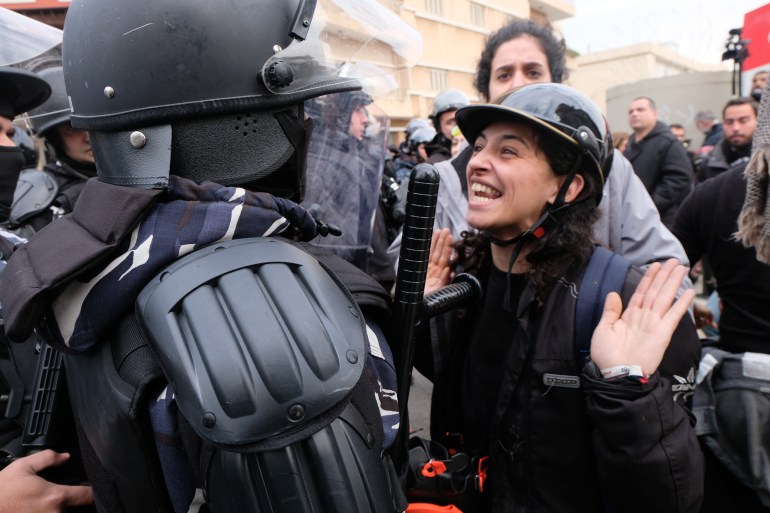 A woman teases a member of the security forces [Timour Azhari/Al Jazeera]
A woman teases a member of the security forces [Timour Azhari/Al Jazeera]Ironically, the population’s lack of faith in politicians may have helped avoid an initial breakout of COVID-19, according to Firas Abiad, the head of the country’s lead COVID-19 treatment facility, Rafik Hariri University Hospital.
“People got scared and part of that fear was that politicians wouldn’t handle it well,” he said.
“At the same time, I’m sure that in those conditions the state was not very unhappy to initiative a lockdown. It was a good pretext to entirely remove people from the streets, and we saw that they did.”
In a dramatic shift, those who had taken their lives into their own hands and practically lived on the streets were now relegated to their homes and bound by government directives.
But the state provided little aid, even to those most in need. While many had tired of the streets, scattered protests quickly returned – this time demanding the simple right to exist.
“We want to eat, we want to live,” protesters in Aley chanted as they marched through deserted streets in April.
The uprising went through a marked shift from aspirational to being focused on basic needs.
No longer were protests coloured by banners, quippy slogans and creative chants. Instead of signboards and Lebanese flags, people held rocks and Molotov cocktails.
Lines of peacemakers had initially kept apart angry protesters and security forces, shouting these were “our brothers”. There were few such peacemakers by spring.
Tired and desperate people pushed against exhausted security forces, and hundreds of injuries were regularly recorded in a single protest by April.
Diab talked the talk – often in stinging speeches where he railed against an unnamed “they”. (The rhetoric seemed almost eerily in tune with what people were saying online).
But he couldn’t walk the walk. Diab was “basically politically inept, and though he was a good guy he was in way above his head”, a government source later said.
The political establishment that named most of the ministers in Diab’s government sabotaged what attempts were made to rescue and reform, such as official controls on money transfers, freeing the judiciary of political intervention and even providing aid to the population. Life got worse.
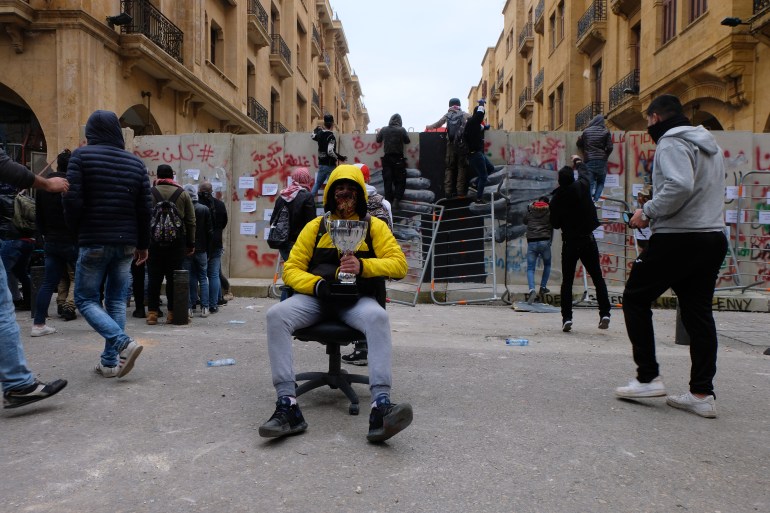 A protester parades a trophy that he removed from a bank in downtown Beirut [Timour Azhari/Al Jazeera]
A protester parades a trophy that he removed from a bank in downtown Beirut [Timour Azhari/Al Jazeera]The currency hit 3,000 lira to $1 by the end of April, shot down to 4,000 by the end of May, and crashed to 8,000 by the end of June. Two days later it hit 9,000.
The minimum wage of 675 thousand pounds, formerly equal to $450, was now worth $80.
Some of those providing aid started to fear becoming impoverished themselves.
Mahmoud Kataya, a 40-year-old anti-corruption activist and financial manager, had helped organise support for dozens of families with food aid at the beginning of the year, along with protest activists.
“We can’t really help anymore today, after what happened with the currency and with our money stuck in the banks,” he said.
“We were a large group and everyone would do a bit – but we’re basically cannibalising ourselves. Soon, I’ll need help.”
With less to go around, crime began to spike. According to numbers from the Internal Security Forces, robberies jumped nearly 50 percent between January and August when compared with the same period the year before, from 1,080 to 1,602.
Double as many cars were stolen: 593 versus 266.
Murders also doubled, from 63 to 129.
On the morning of July 3, Ali al-Haq walked to the Dunkin’ Donuts on Beirut’s Hamra street and placed a copy of his criminal record – clean – on a potted plant.
The 61-year-old had written “I am not a blasphemer” in jagged, red Arabic letters underneath the document, and covered it with a Lebanese flag.
Then, he shot himself in the head.
His words were an apparent reference to a song by famed Lebanese musician and composer Ziad Rahbani, whose lyrics about the harshness of life in civil-war-era Lebanon have never lost their relevance.
“I’m not a blasphemer; hunger is,” the lyrics go. “I’m not a blasphemer; this country is.”
More suicides tied to the crisis would follow. The country’s fall was now unabated and people were losing their grip. Diab was rudderless. Basic symbols of normality like traffic lights stopped working.
Then the earth quaked for the second time that year.
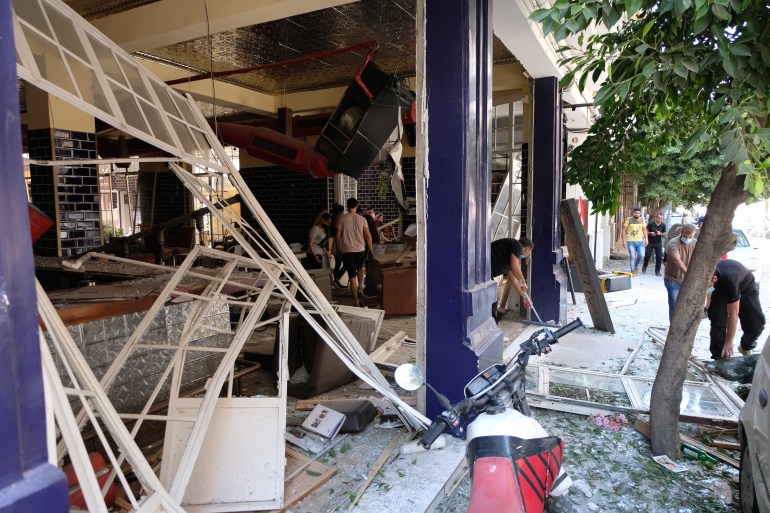 Volunteers clear rubble after the Beirut blast [Timour Azhari/Al Jazeera]
Volunteers clear rubble after the Beirut blast [Timour Azhari/Al Jazeera]A tidal wave explosion
First came the sound, then the ground rumbled. Instinctively, people across the city lifted their heads to the sky – it must be an Israeli air raid, they thought.
Some spotted a large plume of smoke near the sea. Customers at a shop pressed up against a window to get a better look.
A car on a main highway in front of Beirut’s port slowed so the driver could stare at the towering inferno that fizzed and popped like a fission reaction.
Suddenly, an incandescent, airborne tsunami was unleashed and all the glass in the city was airborne.
The tidal wave burst through brick and mortar buildings and twisted metal fixtures into steel wool and flung people through their homes, out of vehicles, out of this world.
Beirut’s mangled skyscrapers were blanketed in a lifeless yellow-gray mist that gave the city the appearance of a single, contiguous mound of dust and rubble. It looked like the dystopian world of 2008 cartoon Wall-E – all signs of life extinguished, leaving only towering piles of garbage.
At the port, containers were crushed like Pringles cans, cars strewn like toys and the large grain silos eviscerated so that their contents spilled into the sea like a massive sandbox.
One of the country’s greatest symbols of corruption – known locally as “The Cave of Ali Baba and the 40 Thieves” for the decades of state-sponsored theft that took place there – had exploded.
It was caused by almost 3,000 tonnes of highly explosive material. It was left there for nearly seven years. It was neglected and officials and judges and security forces knew and nobody did anything.
“My government did this.”
The haunting words were spray-painted on the side of a highway in front of the port.
In the background, the gutted silos loomed like a great tombstone for all those who perished. Nearly 200 would be dead in the end.
In the moments after, there was little news from the area struck. The hyperconnectivity of modern life paused. People could only tend to themselves and the wounded, numbering more than 6,000.
The worst of the state and the best of the people was immediately on display again.
Medical workers and students and an army of volunteers and civil defense did all they could to rescue the wounded, then to begin clearing the rubble and rebuilding.
Security forces patrolled the area but did little to help. No top official visited the victims, but instantly dubbed them “martyrs”.
No one knew for what cause they had died.
In the days that followed, a new macabre symbol gained prominence among the population: The noose.
It was hung from bridges across the country, graffitied on buildings and carried by volunteers.
At a large protest four days after the blast, cardboard effigies of the country’s leaders were hung in Martyrs’ Square. People wanted accountability, but mostly revenge.
Security forces rained down a hail of rubber bullets, tear gas, metal pellets, sticks and fists on an already-wounded people, injuring hundreds.
“We’ve lost everything,” a man repeatedly screamed at soldiers in a hoarse voice that night, in disbelief over the crackdown.
“It’s a miracle that no one was killed,” said George Ghanem, the head of cardiology at the Lebanese American University Medical Center, which received a flood of injured protesters even as medical personnel there continued to treat blast victims.
Facing ministerial resignations, Diab announced his departure. “I said previously that the regime of corruption is deeply rooted in all parts of the state, but I discovered that the regime of corruption is bigger than that state, and that the state is ensnared by this regime and cannot confront it or rid itself of it,” he said.
An investigation into the blast, first spearheaded by military authorities under the administration of a political committee, was transferred to an opaque judicial council.
No top official has been arrested. Few believe the probe will lead to justice for the victims.
A long process
Indeed, one year after the October protests began, there is little to suggest the country’s leaders are more accountable.
A presidential source said the investigation ordered by the president into broken fire-fighting helicopters had found unpaid maintenance contracts to be the issue – something that was already common knowledge.
No one was held responsible. Instead of fixing the helicopters, the source said the government had decided to sell them off.
The billions of dollars transferred abroad by the well-connected have not been returned, nor have the names of those involved been made public despite promises of a thorough investigation.
And despite repeated promises by officials to fight corruption, not a single case against a high-level official made significant progress in the country’s courts.
Meanwhile, since the day the protests began, some 1,400 protesters, activists and journalists have been arrested, interrogated or called in for interrogation by security forces, according to the ad-hoc Lawyers’ Committee to Defend Protesters.
Over the course of the accountability-driven protests, the Red Cross treated 5,339 people, of whom 1,394 were taken to hospital, it said. The total number of protesters injured is likely much higher.
Life in Lebanon has now merged into a seemingly endless series of intertwined sorrows.
During a burial for one of the blast victims, some men fired weapons in the air.
On the other side of town, a bullet hit prominent Lebanese football player Mohammed Atwi in the head. He died a month later.
Three men were shot dead in a northern town.
Streets south of Beirut turned into a war zone amid a firefight sparked by the placement of a religious banner; a 14-year-old died, as did another man.
There was more gunfire at the funeral.
The port ignited again, sending people sprinting away and cowering under furniture and fleeing the city.
An iconic building caught fire. A bakery exploded. A restaurant exploded. Black smoke seemed to rise incessantly from the city.
At Chehab’s 3D design factory, two employees – Ibrahim El-Qaffas and Roshdi al-Gamal – were killed in the blast. Another has left the country.
Two more who were with El-Qaffas and al-Gamal at the time of the explosion are so traumatised that they are unable to work, Chehab said.
“Ibrahim died in the hands of one of them.”
The remaining employees are now making the equivalent of just a few hundred dollars per month, and his company is struggling.
“We work with malls, window displays, exhibitions, weddings and events. There is nothing left of that,” he says.
They now primarily make wooden frames and structures destined for the broken homes and businesses of blast victims.
Despite the country’s spiralling demise, Nassif, and many others, try to maintain their push for change.
In the ruined centre of the city three weeks after the explosion, she was on stage to launch an opposition front of dozens of independent political groups looking to confront the establishment.
She says the blast has catalysed their work, and sees hope in continuing to fill the voids of the state, building alternative institutions and cleaning up the mess of others.
From the fires to protests and through the blast, people like her made oft-unspoken, collective decisions to work hard in the public interest, and for transient moments conjured the outlines of the community they want to live in.
“It’s not going to happen in one year. Change builds over time, its a long process and needs patience,” she says, as if repeating a mantra that she wished she didn’t know was true.
“Hopefully we can stay in this country and take it from them.”

